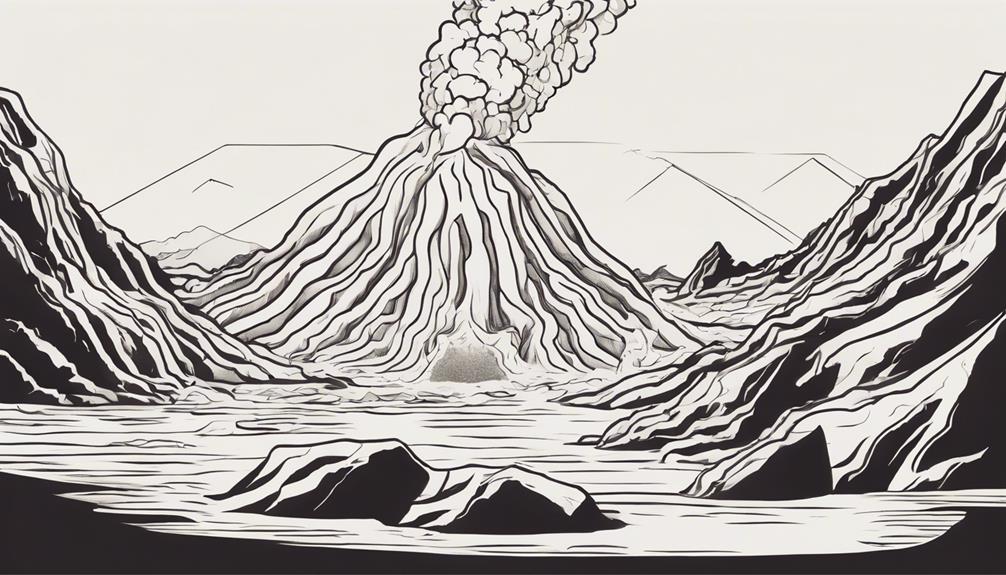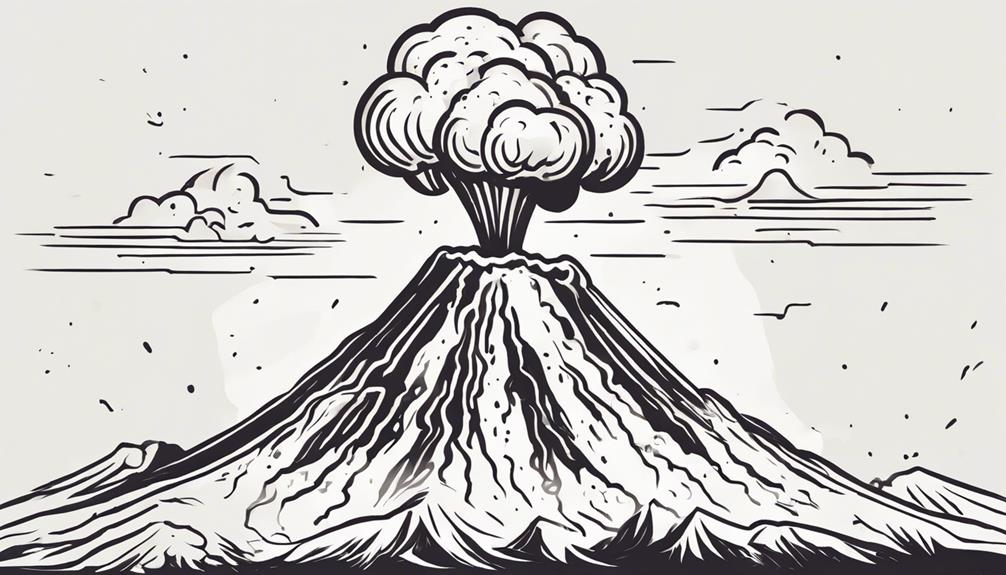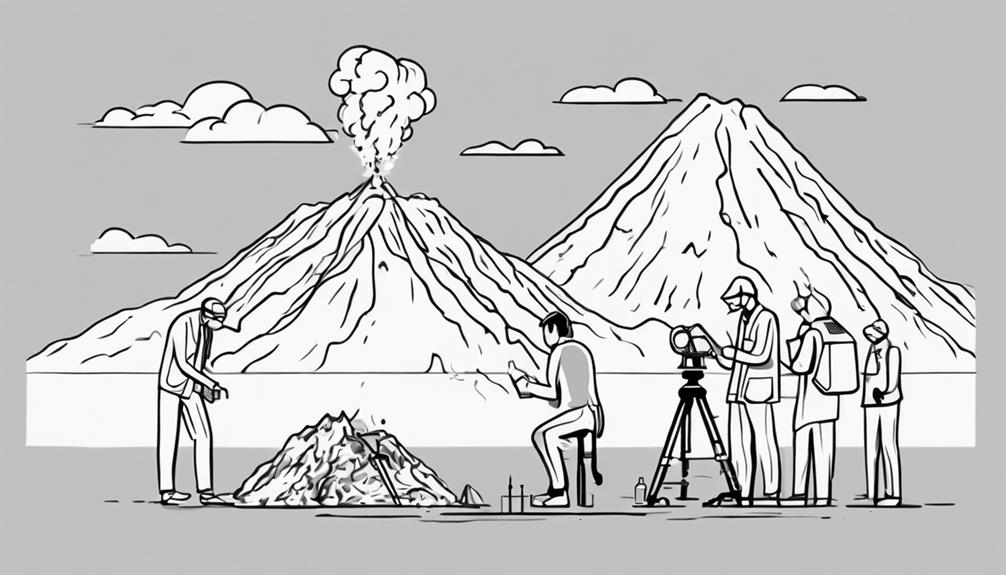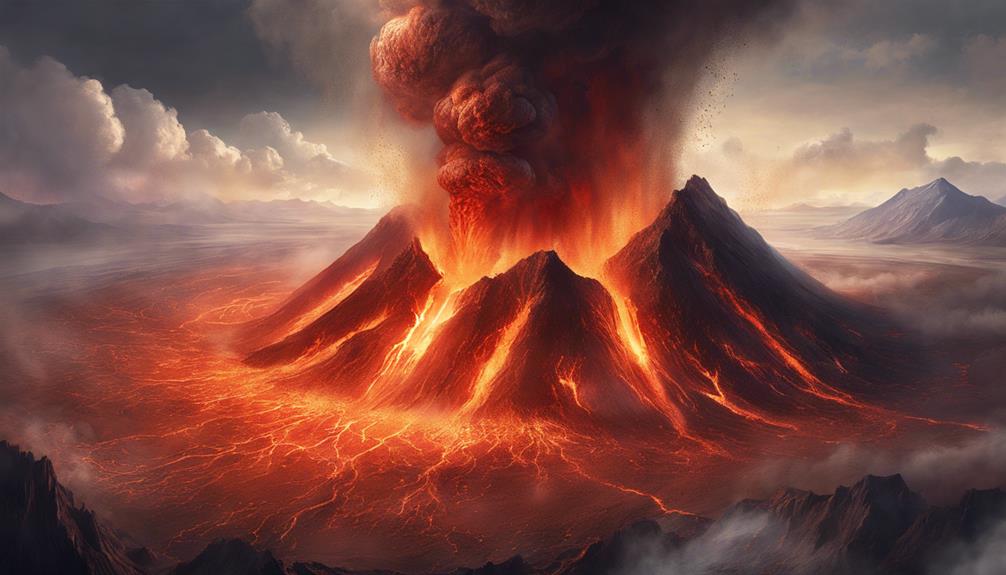Volcanic eruptions, a phenomenon both awe-inspiring and potentially catastrophic, stem from intricate geological processes deep within the Earth. The intricate dance of heat, pressure, and molten rock beneath the Earth's crust sets the stage for volcanic activity, but what exactly triggers these majestic displays of natural power? By exploring the mechanisms behind magma generation, pressure build-up, and the role of tectonic plate movements, we can begin to unravel the enigmatic nature of why volcanoes erupt.
Key Takeaways
- Magma movement driven by melting and buoyancy causes volcanic eruptions.
- Pressure build-up in magma chambers seeks release through explosive eruptions.
- Gas content influences eruption explosivity by impacting magma behavior.
- Tectonic plate movements induce interactions leading to volcanic pressure build-up.
Magma Generation and Movement

Magma generation and movement are fundamental processes driven by the partial melting of Earth's upper mantle and crust, influenced by heat from the planet's interior and the dynamics of buoyancy forces and pressure differentials. When magma forms, it is less dense than the surrounding rocks, prompting its ascent towards the Earth's surface. This movement occurs through channels and fractures in the crust, eventually leading to the formation of magma chambers beneath volcanoes. Magma chambers act as reservoirs where magma accumulates, waiting for the right conditions to erupt.
The rise of magma is a result of buoyancy forces, which push the less dense magma upwards. As magma ascends, pressure differentials within the Earth's crust play a crucial role in shaping its movement patterns. The accumulation of magma in chambers beneath volcanoes sets the stage for volcanic eruptions. Understanding the mechanisms behind magma generation and movement is essential in deciphering the complex processes that culminate in volcanic activities.
Pressure Build-Up in Magma Chamber
The accumulation of magma within chambers beneath volcanoes leads to an increase in pressure, a critical factor in understanding the eruption mechanisms of these geological features. As magma continues to rise and fill the chamber, the pressure within intensifies. This pressure seeks release, often culminating in volcanic eruptions. The build-up of pressure can result in fractures in the surrounding rock, providing pathways for the magma to ascend to the surface. When the pressure in the magma chamber surpasses the strength of the overlying rock, it triggers an explosive eruption characterized by the rapid release of magma and gases.
| Pressure Build-Up in Magma Chamber | |
|---|---|
| Key Points | |
| Accumulation of magma | Increase in pressure |
| Fractures in surrounding rock | Explosive eruption |
| Pathways for magma ascent | Volcanic eruptions |
Role of Gas Content in Eruptions

Gas content within magma is a critical determinant of the explosivity exhibited during volcanic eruptions. The presence of gases such as water, carbon dioxide, and sulfur dioxide influences the behavior of magma as it ascends towards the surface. While deep underground, the dissolved gases are held under pressure within the magma. As the magma rises and nears the surface, the reduction in pressure causes the gases to exsolve, forming bubbles in a process known as vesiculation. The formation and expansion of these gas bubbles can significantly impact the eruption style and intensity. In cases where magma ascends rapidly, there can be a sudden release of gases, leading to explosive volcanic eruptions. Therefore, understanding the gas content in magma is crucial for predicting and evaluating the potential hazards associated with volcanic eruptions. By studying these factors, scientists can better comprehend the mechanisms driving volcanic activity and improve eruption forecasting capabilities.
Tectonic Plate Movements and Eruptions
Tectonic plate movements are fundamental in the process of volcanic eruptions, as they generate various interactions at plate boundaries. These interactions result in the buildup of pressure in magma chambers, which can lead to volcanic activity. Earthquakes often serve as precursors to volcanic eruptions, highlighting the intricate relationship between tectonic plate movements and the eruption of volcanoes.
Plate Boundary Interactions
Plate boundary interactions, through the dynamic movements of tectonic plates, play a crucial role in the generation and eruption of volcanoes worldwide. These interactions, governed by plate tectonics, are key drivers of volcanic activity. At subduction zones, where one plate moves beneath another, the descending plate's melting can lead to magma formation, fueling volcanic eruptions. Diverging plate boundaries create space for magma to rise, generating new crust and volcanic features upon eruption. Transform plate boundaries, where plates slide past each other, can induce seismic activity that triggers volcanic eruptions. The intricate interplay between tectonic plate boundaries and volcanic activity underscores the significance of these geological processes in shaping our planet's landscape and impacting the frequency and intensity of volcanic eruptions.
Magma Chamber Pressure
The formation of magma chambers beneath volcanoes is intricately linked to the dynamic movements of tectonic plates, specifically in relation to the pressure build-up within these chambers.
Key Points:
- Pressure Build-Up: Magma chambers accumulate molten rock from the mantle, increasing pressure within the chamber.
- Tectonic Activity Impact: Intensified tectonic movements can create fractures in the Earth's crust above the magma chamber.
- Eruption Triggers: When the pressure within the magma chamber surpasses the strength of the surrounding rocks, it leads to volcanic eruptions as the magma forces its way to the surface.
This delicate balance of pressure, tectonic activity, and the strength of surrounding rocks plays a crucial role in determining when and how volcanoes erupt.
Earthquake Precursors
As stress accumulates along fault lines due to the dynamic interactions of Earth's crustal plates, seismic activity often serves as a precursor to impending volcanic eruptions. Earthquakes near volcanoes can indicate magma movement, as the pressure and stress exerted by tectonic plate movements can lead to the fracturing of rocks, allowing magma to rise towards the surface. Seismic monitoring plays a crucial role in detecting these ground vibrations caused by tectonic shifts before volcanic eruptions occur. By understanding the complex interplay of tectonic plate interactions, scientists can better predict and study volcanic eruptions, providing vital information for mitigating potential risks associated with volcanic activity.
| Earthquake Precursors | |
|---|---|
| Tectonic Plate Movements | Generate stress and pressure |
| Magma Movement | Indicates potential eruptions |
| Seismic Monitoring | Detects ground vibrations |
| Volcanic Eruptions | Result from tectonic movements |
Influence of Volcano Shape on Eruptions
The shape of a volcano plays a crucial role in determining the nature of its eruptions. Cone-shaped volcanoes, such as stratovolcanoes, often exhibit explosive eruptions due to the steepness of their sides. Additionally, the size of the caldera and crater can also significantly impact the style and intensity of volcanic eruptions.
Cone Shape and Eruptions
Influenced by the cone shape, the eruption dynamics of a volcano are significantly impacted, shaping the intensity and direction of the volcanic activity. The cone shape of a volcano plays a crucial role in determining the type of eruption it experiences. Here's how it affects volcanic eruptions:
- *Explosive Eruptions*: Cone-shaped stratovolcanoes with steep sides often experience explosive eruptions due to pressure buildup within their structure.
- *Magma and Gas Flow*: The volcano's shape influences how magma and gases are expelled during an eruption, affecting the eruption's characteristics.
- *Direction and Intensity*: The cone shape can channel and focus the force of an eruption, determining the intensity and direction of the volcanic activity.
Caldera Impact on Eruptions
When examining the impact of calderas on volcanic eruptions, the shape and formation of these large volcanic craters play a critical role in influencing the eruption dynamics. Calderas, formed by collapsed magma chambers, can release built-up pressure rapidly, affecting eruption direction and force. The circular or elliptical shape of calderas can guide how volcanic eruptions unfold. Massive explosive eruptions that empty magma chambers often lead to caldera formation, triggering subsequent eruptions as new magma fills the void. Understanding calderas' shape and dynamics is crucial for predicting and mitigating volcanic eruptions.
| Caldera Impact on Eruptions |
|---|
| Rapid pressure release |
| Influence on eruption direction |
| Formation from massive explosive eruptions |
| Triggering subsequent eruptions |
| Importance for prediction and mitigation |
Crater Size and Eruptions
Given the critical role that the shape and formation of calderas play in influencing volcanic eruption dynamics, the size and shape of a volcano's crater also significantly impact the type and intensity of eruptions experienced.
Key Points:
- Larger craters with sizable magma chamber sizes may lead to more explosive eruptions due to increased pressure build-up.
- Smaller craters are associated with more frequent but less explosive eruptions as they often have smaller magma reservoirs.
- Crater shapes play a crucial role in determining the direction and flow of lava during eruptions, influencing the extent of impact on surrounding areas.
The variations in crater size and structure offer valuable insights into a volcano's volcanic history and behavior, aiding in understanding its potential eruption patterns.
Environmental Triggers for Eruptions
Environmental triggers play a crucial role in initiating volcanic eruptions, often resulting from various factors such as changes in pressure, gas release from magma, seismic activity, and alterations in magma composition. Changes in pressure within the Earth's crust due to the movement of magma can lead to volcanic eruptions. The release of gases, including water vapor and carbon dioxide, from magma can also contribute to the buildup of pressure and trigger eruptions. Additionally, seismic activity caused by tectonic movements can play a significant role in setting off volcanic eruptions by creating pathways for magma to rise to the surface. Alterations in the composition of the magma, such as changes in gas content or temperature, can further influence the likelihood and intensity of volcanic eruptions. Therefore, understanding these environmental triggers is essential for predicting and mitigating volcanic hazards such as volcanic ash dispersal and lava flows.
Monitoring and Predicting Eruptions

Utilizing advanced monitoring techniques and cutting-edge technology, scientists observe and analyze volcanic activity to predict and prepare for potential eruptions. This proactive approach is essential in mitigating risks associated with volcanic eruptions. Key methods employed in monitoring and predicting volcanic activity include:
- Seismometers: These instruments detect and record ground vibrations caused by volcanic processes such as magma movement, gas explosions, and rock fracturing. By analyzing seismic data, scientists can infer the location and depth of underground volcanic activity.
- Gas Sensors: Monitoring changes in volcanic gas emissions provides crucial insights into the movement of magma beneath the surface. Sudden increases in gas levels, especially sulfur dioxide, can indicate rising magma and impending eruptions.
- Ground Deformation: Techniques such as GPS and satellite-based radar are used to measure ground deformation, which can signal magma accumulation and pressure build-up. Monitoring ground swelling or sinking helps in assessing eruption risks and issuing timely warnings to at-risk populations.
These monitoring techniques, combined with early warning systems, enable scientists to provide valuable insights into volcanic behavior and enhance preparedness for potential eruptions.
Frequently Asked Questions
What Causes Volcanoes to Erupt?
Volcanoes erupt due to a combination of factors. The movement of magma within the Earth's crust creates pressure in the magma chamber. Tectonic plate movements can also contribute by altering the stress on the chamber. Gas pressure from dissolved gases in the magma, temperature changes, and the interaction of magma with surrounding rocks all play roles in eruption triggers. Understanding these factors aids in eruption prediction and mitigating volcanic hazards.
Why Does a Volcano Erupt Essay?
Volcanic eruptions occur when the pressure within the magma chamber exceeds the strength of the surrounding rock, leading to a release of energy. Tectonic plate movements can trigger these eruptions, causing volcanic activity. Monitoring warning signs, such as increased seismicity and gas emissions, can help predict eruptions. Understanding historical eruption patterns and geological factors is crucial in identifying triggers for volcanic activity. By studying these elements, scientists can enhance eruption forecasting and mitigate potential hazards.
What Makes a Volcano Active?
Active volcanoes are defined by recent eruptions within the last 10,000 years. They exhibit ongoing activity due to the movement of tectonic plates, causing pressure buildup in the magma chamber. Monitoring methods track seismicity, gas emissions, and lava flows to assess volcanic activity. Warning signs of potential eruptions include increased seismic activity and gas emissions. Volcanic hotspots are areas with heightened geological activity, contributing to the activation of these volcanoes.
Why Do Volcanoes Erupt for Kids?
Volcanoes erupt due to the movement of magma towards the surface. For kids, understanding this concept can be fun with volcano experiments. By creating a model volcano using household items, children can see how pressure from rising magma causes eruptions. It's important to teach kids about volcano safety during these activities, such as staying away from real volcanoes and following safety guidelines. Encouraging volcano crafts can also engage children in learning about these natural wonders.
Conclusion
In conclusion, volcanoes erupt due to a combination of factors including magma generation, pressure build-up, gas content, tectonic plate movements, volcano shape, and environmental triggers. By understanding these mechanisms, scientists can better monitor and predict volcanic eruptions. While some may argue that predicting eruptions is not always accurate, advancements in technology and research have improved our ability to forecast volcanic activity, ultimately helping to mitigate potential hazards.
